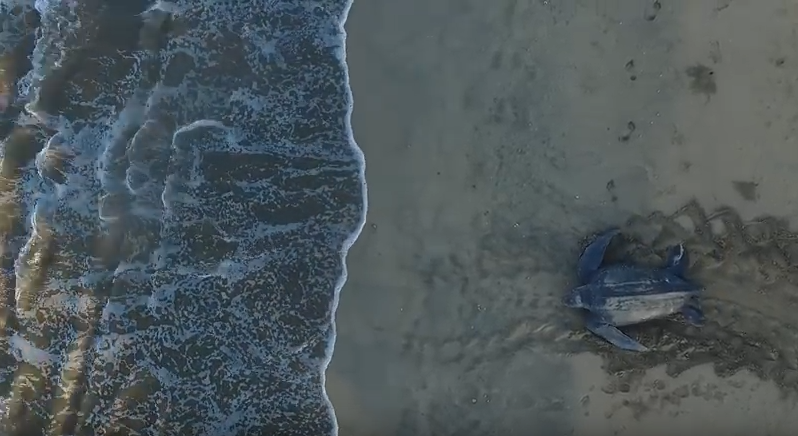- While leatherback sea turtles typically do their nesting at night, a prospective mother turtle is sometimes up so late laying her eggs that she is still on the beach at sunrise.
- It’s a rare sight, but those who are lucky enough to witness it get to watch the endangered turtle slowly make her way back to the ocean before gliding off into the open water.
- Jenell Black, field manager for US- and Costa Rica-based NGO The Leatherback Trust, was conducting a morning survey on Playa Grande, the largest beach in Las Baulas National Park on Costa Rica’s Pacific coast, when she was fortunate enough to observe just such a sight. And fortunately for the rest of us, she had a drone with her at the time.
While leatherback sea turtles typically do their nesting at night, a prospective mother turtle is sometimes up so late laying her eggs that she is still on the beach at sunrise. It’s a rare sight, but those who are lucky enough to witness it get to watch the endangered turtle slowly make her way back to the ocean before gliding off into the open water.
Jenell Black, field manager for US- and Costa Rica-based NGO The Leatherback Trust, was conducting a morning survey on Playa Grande, the largest beach in Las Baulas National Park on Costa Rica’s Pacific coast, when she was fortunate enough to observe just such a sight. And fortunately for the rest of us, she had a drone with her at the time.
“Since light disrupts nesting sea turtles, photographs may not be taken of nesting sea turtles at night, but sea turtles that are up under the bright morning light are free game to take photos of respectfully and without the use of flash,” Black said in a statement. “Our project has been making large efforts to be at the lead of exciting new research methods conducted with drones, and I was lucky enough to remember to bring one out with me so you could witness this exciting event of a leatherback returning to the sea after completing her nesting process.”
You can watch the video right here:
“What is so very exciting about using the drone is that we are able to not only see how the leatherback moves on land, but how graceful she is once she’s in the water clear of the shore,” Black added.
There are seven distinct subpopulations of leatherback sea turtles (Dermochelys coriacea), two in the Pacific Ocean, three in the Atlantic, and two more in the Indian Ocean. The East Pacific subpopulation, to which the female turtle in the video belongs, is listed as Critically Endangered on the IUCN Red List due to the fact that it has declined 97.4 percent over the past three generations. The chief threats to this particular subpopulation include harvesting of eggs for human consumption and being caught as bycatch.
Coastal development is another serious threat facing sea turtles across the globe. As beachfront property is turned into homes and resorts, the construction, dredging, and other changes to the tropical and sub-tropical sandy beaches that are required severely impact habitat the turtles rely on.
And as Black mentioned, the lights that come with such developments are also a problem for leatherbacks: Onshore lights can discourage would-be mother turtles from nesting, and they can disorient hatchlings, making them more vulnerable to predators and potentially even causing them to never reach the water.
“Leatherbacks face different threats at each stage of their lives, specific to the habitats they occupy during those stages,” according to The Leatherback Trust. “To save the leatherback, we must reduce threats in all of the habitats turtles occupy at the various stages of their life cycle.”
CITATION
- Wallace, B.P., Tiwari, M. & Girondot, M. 2013. Dermochelys coriacea (East Pacific Ocean subpopulation). The IUCN Red List of Threatened Species 2013: e.T46967807A46967809. http://dx.doi.org/10.2305/IUCN.UK.2013-2.RLTS.T46967807A46967809.en. Downloaded on 29 March 2017.
Follow Mike Gaworecki on Twitter: @mikeg2001
FEEDBACK: Use this form to send a message to the author of this post. If you want to post a public comment, you can do that at the bottom of the page.

